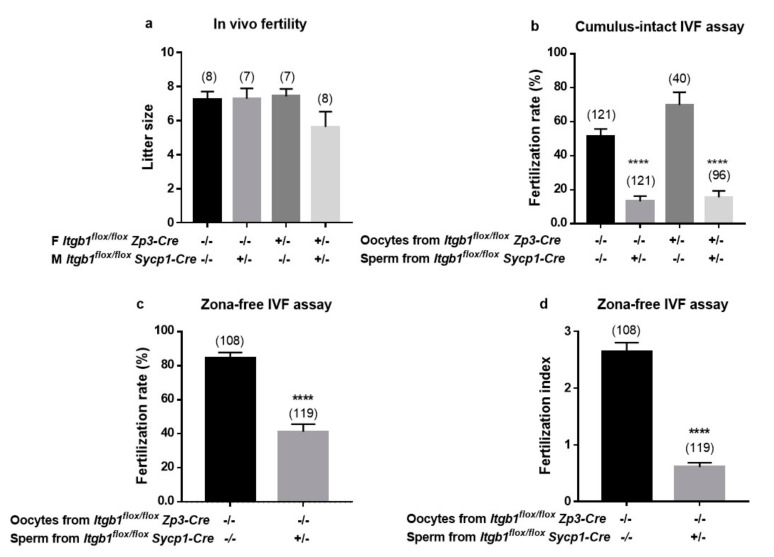Figure 3.
In vivo and in vitro analysis of the fertilizing ability of Sycp1-Cre +/− Itgb1 flox/flox males (M) and Zp3-Cre +/− Itgb1 flox/flox females (F). (a) histogram representing the mean litter size of conditional KO (Zp3-Cre +/− Itgb1 flox/flox) or control (Zp3-Cre −/− Itgb1 flox/flox) females when mated with conditional knockdown (KD) (Sycp1-Cre +/− Itgb1 flox/flox) or control (Sycp1-Cre −/− Itgb1 flox/flox) males, respectively (the numbers in parentheses represent the number of litters in each group). No statistical difference was revealed between the different groups (p = 0.3); (b) fertilization rate (FR) (mean ± s.e.m.) following cumulus-intact in vitro fertilization (IVF) assay at 106 spermatozoa per ml for 3 h. Studies were repeated four times. All males and females were homozygously floxed for Itgb1 gene. The heterozygous presence and expression of the Cre gene in the sperm or oocytes determined the deletion status (KO or KD). The mean FR for Itgb1 KO eggs were 16.5% ± 3.3% and 69.2% ± 7.5% (p < 0.0001) depending on whether the sperm used was from Itgb1 KD males or control, respectively. The mean FR for control eggs were 12% ± 4.6% and 51.2% ± 4.6% (p < 0.0001) depending on whether the sperm used was from Itgb1 KD males or control, respectively; (c,d) FR and fertilization index (FI) (mean ± s.e.m.) following zona-free IVF assay at 105 spermatozoa per ml for 3 h were presented, respectively. The FR dropped from 84.2 ± 3.5 to 41.1 ± 4.5 ((c) p < 0.0001) and the FI dropped from 2.6 ± 0,1 to 0.6 ± 0.07 ((d) p < 0.0001) when wild type (WT) oocytes were inseminated with sperm from control or KD males, respectively. Studies were repeated four times; In (b–d) the numbers in parentheses represent the number of used oocytes analyzed in each group.

